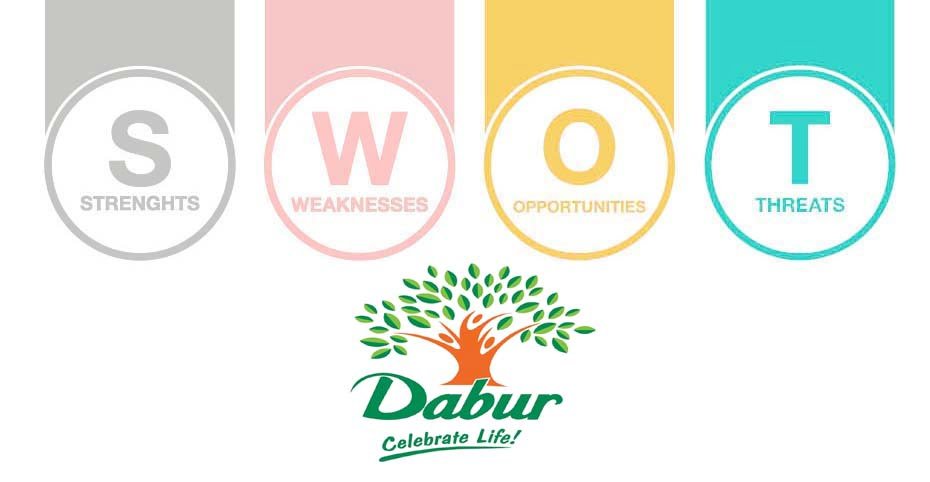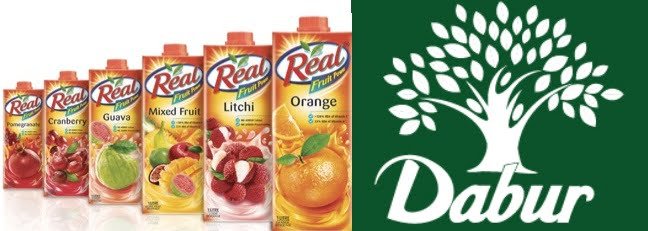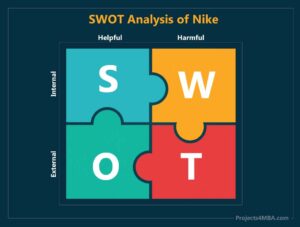SWOT Analysis of Dabur focuses on Strength, Weakness, Opportunities and Threats. Strength and Weakness are the internal factors and Opportunities and Threats are external factors.

Dabur is India’s Largest Ayurvedic Medicine Company. Dr. S.K. Burman is the founder of Dabur. Dabur, which was originally an Ayurvedic pharmaceutical company, started with the launch of the Dabur Real Juices into the fruit-based drinks market. Indian brands did not have a very strong presence on the fruit drinks market that was largely dominated by multinationals such as Tropicana.
Dabur is also manufacturing Real and Real Activ fruit juices that are available in 16 different flavours such as Mosambi, Mango, Plum, Guava, Litchi, Tomato, Pomegranate, Peach, Cranberry, Blackcurrant,Grape and Apricot.

The most popular flavours are Raspberry, Mango, Apple & Mixed Fruit. They also have the Real Activ range, which is concentrate based on sugar free fruit. Dabur is more popular for its chawanprash.
Strengths in the SWOT Analysis of Dabur – Dabur SWOT Analysis
- The fruit juice is available as Real and Real Activ. Both drinks are available in 16 different flavours such as Mosambi, Mango, Plum, Guava, Litchi, Tomato, Pomegranate, Peach, Cranberry, Blackcurrant,Grape and Apricot.
- Real Fruit: The juice’s unique selling proposition is that there are no additives, and that it is made of organic fruit that is then combined with an equivalent amount of water. There are no sugars or spices included in Actual Game, and no preservatives or additives of any type.
- Endorsements and certifications: PFNDAI — Protein Foods & Nutrition Development Association of India endorses Dabur Real Juices for its nutritional quality. The juice in the food & drinks category is also the Reader’s Digest Valued Brand Gold Award 2009.
- Better understanding of the Indian market: In comparison to global brands such as Pepsi, Coca-Cola or Tropicana, Dabur is an Indian business with a deeper understanding of Indian tastes. They introduced Indian fruits such as Mosambi and Guava that are favourites among local audiences.
- Juice composition: Juices contain no artificial additives, and are high in vitamins and antioxidants. Even the Real Activ which has no added sugars is rich in fiber and can be eaten even by patients with diabetes. The company also offers organic juices and a fruit blend.
- Dabur India is the fourth largest FMCG firm with US$ 910 million in revenue
- Dabur has its own history, it is over 100 years old, it was founded in 1884.
- It is present in approximately 60 countries worldwide
- It is the world’s biggest supplier of Ayurvedic medicine
- Dabur has the largest distributors, about 5000 in its respective segment
- The top five master brands to perform are Dabur, Vatika, Hajmola, Actual, Fem
- It has 17 advanced manufacturing facilities
- The length of the prescription involves about 300 approved items and few are sold over the counter
- Categories of Dabur products include health care, personal care , food, home care, consumer health-OTC / ethical, skilled
- Distribution and Reach: In almost every state, Dabur has a large number of dealers, backed by a strong distribution network that ensures that its goods are readily accessible to a large number of consumers in a timely way.
- Cost structure: The low-cost structure of Dabur allows it to manufacture at a low cost and to sell its goods at a low price, making it affordable to its customers.
- Dealer Community: Dabur has a good partnership with its dealers which not only supplies them but also focuses on promoting the products and training of the company.
- Financial position: Dabur has a solid financial position with consecutive earnings over the last 5 years, along with accumulated income reserves that can be used to fund potential capital spending.
- Has a broad asset base offering greater solvency.
- Dabur has invested heavily in its workforce training, which has resulted in it hiring a significant number of professional and motivated workers.
- Has a diverse workforce, with people of many ethnic , racial, cultural and educational backgrounds who help the organization bring in various ideas and methodologies to do things.
- Has trained and certified competent teamworkers.
- Entering new markets: Creative teams from Dabur have helped it to come up with new products and reach new markets. In the past it was successful, in most of the initiatives it took in new markets.
- Social Media: Dabur has a strong social media presence with over millions of followers on the three most prominent social networking platforms : Facebook , Twitter and Instagram. It has a high degree of customer engagement with low customer response time on those channels.
- Website: Dabur has a well-functioning and engaging website that attracts a huge amount of traffic and sales on the internet.
- Product Portfolio: Dabur has a broad selection of products where it sells products in a wide variety of categories. It has a range of exclusive product deals which competitors don’t have.
- Dabur ‘s geography and location give it a cost advantage in servicing its customers as compared with the competition.
- Dabur has a well-established IT system which ensures its internal and external operations are successful.
- Dabur has many intellectual property rights including trademarks and patents. This require exclusivity of their products and rivals are unable to copy or reverse engineer it.
- Dabur is a company that has been on the market for years and that people recognise. That makes it highly aware of its brand.
- Over the years, its goods have retained consistency and are still respected by consumers, who regard it as good value for the price they spend.
- Relationships: Dabur develops strategic partnerships with its manufacturers , distributors, retailers and other interested parties. This helps it to use them in the future if need be.
Weaknesses in the SWOT Analysis of Dabur – Dabur SWOT Analysis
- Image: Dabur has always been associated with the pharmaceutical and medical industries, making it difficult for them to take up the picture of a business selling fruit juice compared to their rivals such as Tropicana or Coca-Cola, who had established their presence on the juice market.
- Indian customs: The Indian customs are very different from the Western world where fruit juice is drunk during breakfast. Fruit juice here is something given to tourists, or rarely drank. That reduced purchase frequency.
- Packaging: Real Fruit Juices have no chemicals or preservatives and thus the business has had to invest extensively in evaluating packaging technology to maintain the freshness and consistency of their beverages. The short shelf life often poses problems in the management of distribution networks.
- Cost: Real Fruit Juice is expensive compared to aerated beverages such as Pepsi or Coca-Cola, and thus may not be preferred by all consumers. Another problem here is that such drinks aren’t viewed as choices for value for money.
- Acquired Taste: Dabur Real Juices has no fresh juice flavor, and is claimed to have a medicinal flavour. Customers may need to get used to the juice ‘s taste to start enjoying the flavor making it a taste they’ve acquired.
- Dabur has no direct channels to the business
- The lack of consumer knowledge of the goods
- Doctors prescribe allopathy medicines because they earn more benefits from medical firms and the proportion of ayurvedic firms is smaller than allopathy.
- According to a survey , the number of licensed practitioners of Ayurveda is less than 3.7, a negligible amount compared to doctors of allopathy.
- Ayurvedic medicine needs time to heal compared to treatment with allopathy
- Research and Development: While Dabur is investing more than the industry’s average expenditure on research and development, it is investing much less than a few market leaders who have had a major advantage as a result of their revolutionary goods.
- High Day Sales Inventory: The time it takes to buy and sell goods is higher than the industry average, which ensures that inventory builds up adding additional costs to the company.
- Integration: The existing structure and culture of Dabur has resulted in the failure of numerous mergers that seek to integrate vertically.
- Workforce diversification: Dabur ‘s workforce is concentrated mainly with white employees, with small numbers of staff from other ethnic backgrounds. Lack of diversification makes transition at the workplace challenging for workers from various ethnic backgrounds, leading to a loss of talent.
Opportunities in the SWOT Analysis of Dabur – Dabur SWOT Analysis
- High market potential for packaged drinks in India: the packaged drinks industry has a market size of about 100 crores of INR and is projected to rise at about 18 percent per year. For an Indian business like Dabur this is a big opportunity.
- Favourable climate in India: Domestic businesses have a lot to gain in terms of government funding with the government promoting “Make in India” In addition, the food processing industry is given several concessions.
- Dabur is the largest Ayurvedic medicine in the world and its export volumes are constantly in demand in the foreign market
- Yoga and Hindu association is proving more beneficial to the global penetration of ayurvedic medicines
- People have begun to understand that Ayurvedic medicines such as Dabur, Himalayas etc have no side effect
- Growing earning power for women has made them independent and made them more health-conscious and attractive – a segment in which Dabur also seeks to capitalize on its products
- Improper and unhealthy eating habits due to modernization forced people to take supplementary Ayurvedic medicines such as Chavanaprash, Hajmola and Life Style medicines
- In the last 2–3 years, Ayurveda as a area has gained much more attention all over the world. So Dabur has an immense opportunity to capitalize on investor sentiments.
- Internet: The number of internet users around the world has been growing. That means there’s an opportunity to broaden their online presence; using the internet to connect with their customers.
- E-commerce: The e-commerce industry has undergone a new phenomenon and a increase in revenue. That means a lot of people are making online transactions now. Dabur can gain money by opening and making purchases through these online stores.
- Social networking: The number of social media users worldwide has grown. The three social media platforms ; Facebook , Twitter, and Instagram have recorded the highest number of monthly active user rises. Dabur may use social media to advertise its goods, communicate with clients and gather feedback.
Threats in the SWOT Analysis of Dabur – Dabur SWOT Analysis
- Low entry barriers: There are minimal to no entry barriers in the fruit drinks market and there is competition in all forms and shapes. Even small to medium-sized enterprises are setting up local production units which make fruit juices.
- Competition: Minute Maid, Onjus, Coca-Cola, Pepsi, Mirinda, Slice, Maaza, Frooti, and Tropicana are among Dabur Real’s main competitors.
- Companies Producing Ayurvedic Medicines and Allopathic medicines are the major threats to Dabur.
- Some ayurvedic doctors offer their own medicines or offer a mix of the medication without packaging (loose medicines) from the Ayurvedic Business. This decreases retail sales and diluts the brand image
- Since traditional practice of ayurvedic medicine is obtained, there are many untrained professions that take up the profession
- Many Ayurvedic medicines contain more lead and ferric material, which can often lead to reverse side effects when taken for a longer period of time.
- For most treatments Kerala is an Ayurvedic centre. That’s why people visit health camps directly to get cured.
If you like This Article Please Like our Facebook Page PROJECTS4MBA
Cite This Work
Referencing Style to cite this article:
[citationic]

